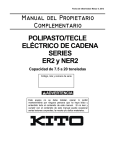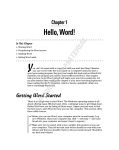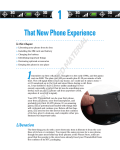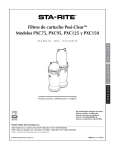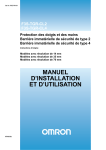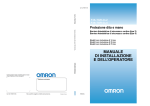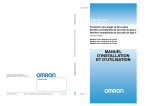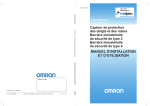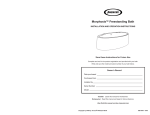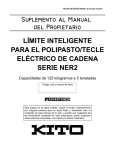Download Harrington Hoists ER2 User's Manual
Transcript
EFFECTIVE: November 3, 2008 Owner’s Manual SUPPLEMENT ELECTRIC CHAIN HOIST ER2 and NER2 SERIES 8 Ton through 20 Ton Capacity Code, Lot and Serial Number WARNING This equipment should not be installed, operated or maintained by any person who has not read and understood all the contents of this manual. Failure to read and comply with the contents of this manual can result in serious bodily injury or death, and/or property damage. IMPORTANT INFORMATION ON HOW TO USE THIS MANUAL This OWNER’S MANUAL SUPPLEMENT is intended for use in combination with the “Owner’s Manual for Electric Chain Hoist ER2 and NER2 Series 1/8 through 5 Ton Capacity”. Refer to the Table of Contents below to determine the location(s) of information pertaining to your hoist. References to the “Owner’s Manual for Electric Chain Hoist ER2 and NER2 Series 1/8 through 5 Ton Capacity” will be designated by the use of the acronym “ER2OM”. Table of Contents Section 1.0 2.0 3.0 4.0 Page Number/Location Important Information and Warnings…...………………...………………………………………. ER2OM 1.1 Terms and Summary ER2OM 1.2 Warning Tags and Labels ER2OM Technical Information………………………………………………………………………….…..………... 4 2.1 Specifications 4 2.2 Dimensions 5 Preoperational Procedures ………………………………………………………………………………… 7 3.1 Fill Gear Box with Oil 7 3.2 Chain 8 3.3 Mounting Location 9 3.4 Mounting the Hoist 9 3.5 Electrical Connections 10 3.6 Preoperational Checks and Trial Operation 14 Operation………………………………………………………………………………………..….. ER2OM 4.1 Introduction ER2OM 4.2 Shall’s and Shall Not’s for Operation ER2OM 4.3 Hoist Controls ER2OM 2 Section 5.0 6.0 7.0 Page Number/Location Inspection…………………………….………………………………….…………..…….. 15 and ER2OM 5.1 General ER2OM 5.2 Inspection Classification ER2OM 5.3 Frequent Inspection ER2OM 5.4 Periodic Inspection ER2OM 5.5 Occasionally Used Hoists ER2OM 5.6 Inspection Records ER2OM 5.7 Inspection Methods and Criteria 15 and ER2OM Maintenance & Handling…………………………………………………….……………. 18 and ER2OM 6.1 Count/Hour Meter ER2OM 6.2 Lubrication 18 and ER2OM 6.3 Motor Brake 18 and ER2OM 6.4 Load Chain 19 and ER2OM 6.5 Friction Clutch and Mechanical Load Brake with Friction Clutch ER2OM 6.6 Storage ER2OM 6.7 Outdoor Installation ER2OM Troubleshooting……………………………………………………………………………….…… ER2OM 3 2.0 Technical Information 2.1 Specifications 2.1.1 Product Code 2.1.2 Operating Conditions and Environment Temperature range: Relative Humidity: Noise Level: Enclosure Rating: Supply Voltage: -4° to +104°F (-20° to +40°C) 85% or less 85 dB or less (A scale: measured 1 meter away from electric chain hoist Hoist Meets IP 55, Pendant Meets IP65 Single Speed Standard: Reconnectable 208/230 & 460V-3-60 Single Speed Optional: 575V-3-60 or Special Voltages/Frequencies Available Dual Speed Standard: 208/230V-3-60 or 460V-3-60 Dual Speed Optional: 575V-3-60 or Voltages/Frequencies Voltages Available Hoist Duty Rating: Intermittent Duty Rating: Short Time Duty Rating: Single Speed Dual Speed ISO M4; FEM 2M; ASME H4 60% ED 40/20% ED 360 starts per hour 120/240 starts per hour 60 min. 30/10 min. 4 Table 2-1 Hoist Specifications Output (Hp) 208V 230V 460V 4.7 16.4 7.9 Load Sheave Pockets 11.2 x 3 8 10 10 10 15 20 (N)ER2080S* (N)ER2100L (N)ER2100L-LG (N)ER2100S (N)ER2150S (N)ER2200S 7.5 Single Speed Product Code Load Chain Diameter (mm) x Chain Fall Lines 11 7.5 5.5 4.7 x 2 4.7 x 2 4.7 x 2 16.4 x 2 16.4 x 2 16.4 x 2 7.9 x 2 7.9 x 2 7.9 x 2 11.2 x 4 11.2 x 6 11.2 x 8 5 5 5 5 5 5 Dual Speed Cap. (Tons) Lifting Speed (ft/min) Motor Rated Current (amps) 8 10 10 10 15 20 (N)ER2080SD* (N)ER2100LD (N)ER2100LD-LG (N)ER2100SD (N)ER2150SD (N)ER2200SD 7.5/2.5 5.5/2 5.5/2 11/3.5 7.5/2.5 5.5/2 4.7 4.7 4.7 4.7 x 2 4.7 x 2 4.7 x 2 17.3 17.3 17.3 17.3 x 2 17.3 x 2 17.3 x 2 8.3 8.3 8.3 8.3 x 2 8.3 x 2 8.3 x 2 11.2 x 3 11.2 x 4 11.2 x 4 11.2 x 4 11.2 x 6 11.2 x 8 5 5 5 5 5 5 5.5 11.2 x 4 Net Weight (lbs) NER ER Weight for Addnl. One Foot of Lift (lbs) 362 617 573 668 891 1049 359 615 571 666 886 1045 5.5 7.4 7.4 7.4 11.4 14.8 358 609 569 650 873 1032 366 622 578 677 899 1058 5.5 7.4 7.4 7.4 11.4 14.8 *Available lug mount only. Push button cord dimension (L) is to center of lug hole. **Although both 208/230 & 460 Volts are shown together, the dual speed hoist motors are NOT reconnectable. 2.2 Dimensions Table 2-2 Hoist Dimensions e (in) Product Code NER ER NER ER NER ER Single Speed d (in) 8 10 10 10 15 20 (N)ER2080S (N)ER2100L (N)ER2100L-LG (N)ER2100S (N)ER2150S (N)ER2200S 40.3 53.9 40.9 53.9 62.8 67.3 29.0 29.0 29.0 31.4 31.4 31.4 32.5 32.5 32.5 33.6 33.6 33.6 23.2 38.3 26.9 33.4 40.2 47.2 13.3 13.3 13.3 15.7 15.7 15.7 16.8 16.8 16.8 16.8 16.8 16.8 15.7 15.7 15.7 15.7 15.7 15.7 Dual Speed a (in) Headroom C (in) 8 10 10 10 15 20 (N)ER2080SD (N)ER2100LD (N)ER2100LD-LG (N)ER2100SD (N)ER2150SD (N)ER2200SD 40.3 53.9 40.9 53.9 62.8 67.3 31.5 31.5 31.5 31.5 31.5 31.5 32.5 32.5 32.5 33.6 33.6 33.6 23.2 38.3 26.9 33.4 40.2 47.2 15.8 15.8 15.8 15.8 15.8 15.8 16.8 16.8 16.8 16.8 16.8 16.8 15.7 15.7 15.7 15.8 15.8 15.8 Cap. (Tons) b (in) 5 g (in) h (in) i (in) 16.8 16.8 16.8 16.8 16.8 16.8 2.4 3.2 3.2 3.2 3.4 4.0 11.1 13.3 13.3 - 7.1 20.0 8.5 - 15.7 15.7 15.7 16.8 16.8 16.8 2.4 3.2 3.2 3.2 3.4 4.0 11.1 13.3 13.3 - 7.1 20.0 8.5 - Figure 2-1 – NER2080S Figure 2-2 – NER2080SD Figure 2-3 – NER2100S Figure 2-4 – NER2100SD Table 2-3 Hook Dimensions* T = Top Hook B = Bottom Hook Units = in.(mm) Capacity Code Hook a b c d e g 080S B 3.3 (83.5) 2.2 (55.0) 2.9 (73.0) 1.9 (48.0) 3.3 (85.0) 2.4 (62.0) 100L, 100S T&B 3.3 (83.5) 2.2 (55.0) 2.9 (73.0) 1.9 (48.0) 3.3 (85.0) 2.4 (62.0) 150S T&B 4.1 (104) 2.8 (70.0) 3.4 87.0) 2.4 (60.0) 3.9 (100.0) 3.1 (79.0) 200S T&B 4.6 (118) 3.3 (83.0) 3.9 (99.5) 2.8 (70.0) 4.3 (110.0) 3.4 (86.0) *Refer to EROM Section 5.7 for inspection dimensions and limits. 6 3.0 Preoperational Procedures 3.1 Gear Box 3.1.1 The gearbox is filled with the correct amount of oil at the time of shipment. The oil level must be verified prior to operation. The ER2 and NER2 hoists have different checking procedures. Refer to Section 6.3 of the ER2OM for specific checking procedures. Use the 050L Capacity Code to determine the correct “Check Distance” for the ER2 Large Capacity hoist. 3.1.2 Refer to Section 6.3 of the ER2OM when replacing the gear oil. Use the 050L Capacity Code to determine the correct amount of gear oil. 3.1.3 All ER2, mechanical load brake installed, hoists are shipped with a separate air vented oil cap. This vented oil cap must be installed prior to use. To install, remove an existing oil cap and replace with the vented oil cap (refer to Figure 3-1). 3.1.4 There are two oil fill holes located in the top of the gear case on the ER2 hoist. For ER2 coupled to MR2 trolley, there are some flange widths that make it necessary to relocate the oil cap assembly to the other oil fill hole. This will prevent interference with trolley side plate. Refer to Figure 3-1. Figure 3-1 Vented Oil Cap Installation 7 3.2 Chain 3.2.1 The quantity and location of the chain components including chain springs and stoppers depends on the hoist model and capacity. Never operate the hoist with incorrect, missing or damaged chain components. Refer to the hoist's nameplate, Table 3-2, and Figure 3-2 and ensure that all chain components are in the correct location and properly installed. 3.2.2 When the hoist is used without a chain container, the free end of the chain is attached to the hoist body as shown in Figure 3-2. Connect the “no load” end of the chain to Chain Guide A and the pre-installed socket bolt and lock nut. Make sure the chain remains free of twists and the chain Stopper is installed on the correct link. Refer to Table 3-2 for proper placement of Stopper. Figure 3-2 Chain Component Arrangement Table 3-2 Chain Stopper Placement Capacity Code Without Chain Container With Chain Container 080S, 100L, 100S, 15th link from the free end 3rd link from the free end 150S, 200S *Tightening torque for the Stopper Bolt: 10 N-m (7 lb-ft) 3.2.3 3.2.4 When the optional canvas chain container(s) is used, unfold it fully and install it on the hoist body(ies) as shown in Figure 3-3. In this case the free end of the chain is not attached to the hoist body and the chain stopper is installed on the third link from the free end. To place the chain into the chain container(s), feed the chain into the chain container(s) beginning with the free end. Take care to avoid twisting or tangling the chain. NEVER put all the chain into the container(s) at once. Lumped or twisted chain may activate the down limit switch and stop the hoist during lowering. CAUTION Each chain container indicates the maximum length of the load chain that can be stored in the container. The amount of chain the container must hold is equal to the lift on the hoist. DO NOT use a chain container with a storage capacity less than the lift length on the hoist. If all of the chain can not be stored in the container, the limit switch will not operate properly. 8 (N)ER2100S to (N)ER2200L (N)ER2080S to (N)ER2100L Figure 3-3 Installation of Chain Container 3.2.5 When using an optional steel chain container, refer to the instructions and/or assembly drawing(s) provided with the container for correct assembly and attachment. WARNING 3.2.6 Verify that the load chain is not twisted or tangled prior to operating the hoist. Make sure the bottom hook is not capsized. See Figure 3-4. Correct all chain irregularities before conducting the first hoist operation. 3.2.7 Lubricate the entire length of the load chain with the supplied tube(s) of grease per the instructions in Section 6.2.1. Figure 3-4 Capsized Hook and Chain 3.3 Mounting Location 3.3.1 3.3.2 3.4 WARNING Prior to mounting the hoist ensure that the suspension and the supporting structure are adequate to support the hoist and its loads. If necessary consult a professional that is qualified to evaluate the adequacy of the suspension location and its supporting structure. NOTICE See Section 6.8 of the ER2OM for outdoor installation considerations. Mounting the Hoist 3.4.1 Manual Trolley - Follow instructions in Owner’s Manual provided with the trolley. 3.4.2 Motorized Trolley - Follow instructions in Owner’s Manual provided with the trolley. 3.4.3 Hook Mounted to a Fixed Location - Attach the hoist’s top hook to the fixed suspension point. 9 3.4.4 3.4.5 3.5 Lug Mounted ER2080S and ER2100L-LG – To maintain proper balance when the hoist is not loaded, it is necessary to install a stabilizing shaft to prevent the hoist from pivoting on the main support shaft. Refer to Figure 2-1 and Figure 2-2 for the size and location of the main support and stablizing holes in the hoist’s top suspension plates. WARNING Ensure that the fixed suspension point rests on the center of the hook’s saddle and that the hook’s latch is engaged. Electrical Connections 3.5.1 3.5.2 3.5.3 3.5.4 3.5.5 CAUTION Ensure that the voltage of the electric power supply is proper for the hoist or trolley. CAUTION Do NOT apply electronic soft-start control or voltage varying controls to the ER2 or NER2 hoist. Use of such devices may cause the motor brake and other electrical components to malfunction. Variable frequency drives MAY be used with the single speed ER2/NER2 hoists, contact Harrington Hoists, Inc. for more information. DANGER Before proceeding, ensure that the electrical supply for the hoist or trolley has been de-energized (disconnected). Lock out and tag out in accordance with ANSI Z244.1 “Personnel Protection -Lockout/Tagout of Energy Sources”. DANGER To avoid a shock hazard, DO NOT perform ANY mechanical or electrical maintenance on the dual speed ( VFD control) trolley or hoist within 5 minutes of de-energizing (disconnecting) the trolley or hoist. This time allows the internal VFD capacitor to safely discharge. DANGER Do NOT remove power to the dual speed (VFD control) hoist or trolley during operation. 3.5.6 3.5.7 CAUTION All dual speed hoists are equiped with a VFD. The VFD is used to control the high and low lifting speeds. The speeds come preset from the factory (See Table 3-6, ER2OM). Speed (frequency) can be customized. Refer to Section 3.6.10 of ER2OM, for hoist specific speed ranges and instructions. The following instructions apply when the hoist is hook mounted to a fixed suspension point or installed on a manual trolley. The hoist is controlled by a pendant with two push buttons – one for lifting and one for lowering. Refer to the appropriate trolley Owner’s Manual if the hoist is installed on a motorized trolley. Special wiring considerations must be taken if the trolley is used with a trolley other than an MR2 model. Pendant Cord The Pendant Cord connects to the hoist via an 8-pin (8P) Plug and Socket. Make this connection as follows: Refer to Figure 3-5 or 3-6 depending on the Product Code. For ER2080S and ER2100L - Insert the 8P Plug into the 8P Socket on the hoist body and hand tighten the Lock Ring. Install the strain relief cable to the bottom of the hoist body. For ER2100S, ER2150S and ER2200S - Insert the 8P Plug into the 8P Socket on the switch box and hand tighten the Lock Ring. Install the strain relief cable onto the cord strain relief stopper located at the 8P socket. 10 Power Supply Cable - Hoist Connection The Power Supply Cable connects to the hoist via a 4-pin (4P) plug and socket or a direct fitting depending on the product code. Make this connection as follows: Refer to Figure 3-5 or 3-6 depending on the product code. For ER2080S and ER2100L insert the 4P plug of the Power Supply Cable into the 4P Socket on the hoist and hand tighten the Lock Ring. For ER2100S, ER2150S, and ER2200S – The power supply cable should be pre-installed to the switch box and properly connected. Install the Cable Support Arm (pre-installed on the Power Supply Cable) on to the Socket Holder or Switch Box depending on the product code. Use the pre-installed Machine Screws and Lock Washers. Use care to avoid twisting or kinking the Power Supply Cable. Insert the 4P Plug into the 4P Socket on the hoist and hand-tighten the Lock Ring. Figure 3-5 Pendant and Power Supply Cable Connections for ER2080S and ER2100L 11 Figure 3-6 Pendant and Power Supply Cable Connections for ER2100S, ER2150S and ER2200S Figure 3-7 Power Supply Cable Festooning and Guide Wire Location 12 Power Supply Cable - Installation If the hoist is hook mounted to a fixed support ensure that the Power Supply Cable is properly installed and supported between the hoist and the electrical power supply. If the hoist is installed on a manual trolley, then the Power Supply Cable must be installed along the beam that the trolley runs on. For curved beams a special cable suspension system will be needed, and this instruction does not apply. For straight beams install the Power Supply Cable as follows: Refer to Figure 3-7. Install the Cable Hangers on to the Power Supply Cable spacing them every 5 feet. Install a Guide Wire system parallel to the Bridge Beam. Pass the Guide Wire through the Cable Hangers and the Wire Guide. Make sure the Guide Wire is properly tensioned and the Power Supply Cable is not twisted or kinked. 3.5.8 Connection to Electrical Power Source - The red, blue, and black wires of the Power Supply Cable should be connected to an Electric Power Disconnect Switch or Circuit Breaker. This connection should be made so that the hoist is phased properly. Refer to Section 3.6.11 for instructions on how to check for correct power supply phase connection. 3.5.9 Fuse/Breaker Capacity -The hoist's power supply should be equipped with overcurrent protection such as fuses, which should be selected for 110% to 120% of total listed full load amperage, and should be dual element time-delay fuses. Refer to the motor nameplate(s) for the full load amperage draw. 3.5.10 DANGER Grounding - An improper or insufficient ground connection creates an electrical shock hazard when touching any part of the hoist or trolley. In the Power Supply Cable the ground wire will be either Green with Yellow stripe or solid Green. It should always be connected to a suitable ground connection. Do not paint the trolley wheel running surfaces of the beam as this can affect grounding. 13 3.6 Preoperational Checks and Trial Operation 3.6.1 3.6.2 Refer to the hoist’s nameplate and record the hoist's Code, Lot and Serial Number in the space provided on the cover of this manual. WARNING Confirm the adequacy of the rated capacity for all slings, chains, wire ropes and all other lifting attachments before use. Inspect all load suspension members for damage prior to use and replace or repair all damaged parts. WARNING 3.6.3 Verify and correct all chain irregularities prior to operating the hoist. Refer to Section 3.2 of this manual. 3.6.4 Measure and record the “k” dimension of all hooks on hoist. See Table 5-4 under Section 5 “Inspection”, of this manual. 3.6.5 Ensure that the hoist is properly installed to either a fixed point, or trolley, whichever applies. 3.6.6 If hoist is installed on a trolley, ensure that trolley is properly installed on the beam, and stops for the trolley are correctly positioned and securely installed on the beam. 3.6.7 Ensure that all nuts, bolts and split pins (cotter pins) are sufficiently fastened. 3.6.8 Pull down on the Pendant and ensure that the Cord Strain Relief Cable takes the force, not the Pendant Cord. 3.6.9 CAUTION Check supply voltage before everyday use. If the voltage varies more than 10% of the rated value, electrical devices may not function normally. 3.6.10 Confirm proper operation. Before operating read and become familiar with Section 4 – Operation in the ER2OM. Before operating ensure that the hoist (and trolley) meets the Inspection, Testing and Maintenance requirements of ANSI/ASME B30.16. Before operating ensure that nothing will interfere with the full range of the hoist’s (and trolley’s) operation. 3.6.11 Proceed with trial operation to confirm proper operation. Verify that the controls agree with hoist direction. Make sure that depression of the up button lifts the load chain and depression of the down button lowers the load chain hook. If the load chain does not move in the correct direction when the push buttons are pushed, the power supply is phased incorrectly. In this case, turn off the power source or breaker switch then reverse any two of the three wires at the power source. The hook will then move in accordance with the directions of the push button. Perform inspections per Section 5.2, “Frequent Inspections” in the ER2OM. 14 5.0 Inspection NOTICE The information listed in this section is intended to supplement Section 5.7 of the ER2OM. Table 5-3 Hoist Inspection Methods and Criteria Use this table in conjunction with Table 5-3 of the ER2OM. The entries in this table replace in their entirety the corresponding entries in Table 5-3 of the ER2OM. Item Method Criteria Action Hooks - Fretting wear Measure The "u" and "t" dimensions should not be less than discard value listed in Table 5-4 Replace. Hooks - Stretch Measure The "k" dimension should not be greater than 1.15 times that measured and recorded at the time of purchase (See Section 3.6). If recorded "k" values are not available for hooks when new, use nominal "k" values from Table 5-4. Replace. Load Chain - Pitch and Wire Diameter Measure The "P" dimension should not be greater than maximum value listed in Table 5-5. The "d" dimension should not be less than minimum value listed in Table 5-5. Replace. Inspect Load and Idle Sheaves. Load Chain – Reeving and Evening Visual Chain should be reeved properly through Load and Idle Sheaves - refer to Section 6.4. Chain, Chain Springs, Stoppers, and Chain Pin should be installed properly - refer to Section 3.2. For double body hoists, chain should be evenly distributed – equal length of chain in each chain container or equal lengths of chain on no-load side of each hoist body. Reeve/Install chain properly. Chain Springs Visual Chain springs should not be deformed or compressed. Refer to Table 5-6 for Chain Spring dimensions. 15 Lower hook until lower limit switch is activated on both hoist bodies. Replace. Table 5-4 Top Hook & Bottom Hook Dimensions “k” Measured When New: Top: _________________________ Bottom: ______________________ "u" Dimension inch (mm) "t" Dimension inch (mm) Nominal "k" Dimension* inch (mm) Standard Discard Standard Discard 080S 4.76(121) 2.86(72.6) 2.72(69) 1.89(48) 1.8(45.6) 100L, 100S 5.16(131) 3.43(87) 3.26(82.7) 2.36(60) 2.24(57) 150S 5..6(142) 3.91(99.4) 3.72(94.5) 2.76(70) 2.62(66.5) 200S 7.13(181) 4.4(112) 4.19(106.4) 2.8(71) 2.66(67.5) Capacity Code * These values are nominal since the dimension is not controlled to a tolerance. The "k" dimension should be measured when the hook is new - this becomes a reference measurement. Subsequent measurements are compared to this reference to make determinations about hook deformation/stretch. See Section 5.7 of ER2OM, “Hooks - Stretch”. Table 5-5 Chain Wear Dimensions Capacity Code 080S, 100L, 100S, 150S, 200S “P” Dimension inch (mm) “d” Dimension inch (mm) Standard Discard Standard Discard 6.18 (157.0) 6.37 (161.7) 0.44 (11.2) 0.42 (10.6) 16 Table 5-6 Chain Spring Length Dimensions “Length” - inch (mm) Capacity Code 080S, 100L, 100S, 0150S, 200S 17 Standard Discard 6.3 (160) 6.0 (152) 6.0 Maintenance and Handling 6.2 Lubrication 6.2.1 Load Chain 6.2.2 Hooks and Suspension Components: 6.2.3 Refer to 6.2.1 of the ER2OM. Refer to 6.2.2 of the ER2OM. Gear Box: Refer to 6.3 of the ER2OM except use the following table for checking oil level. Table 6-1 ER (Mechanical Load brake Equipped) Gear Oil Check Distances 6.3 Capacity Code Check Distance (inches) Check Distance (millimeters) 080S, 100L, 100S, 0150S, 200S 5.12 130 Motor Brake - Use the table below in conjunction with Section 6.4 of the ER2OM. Table 6-2 Motor Brake Wear/Gap Dimensions Capacity Code "Gap" Discard Dimension - inch (mm) 080S, 100L, 100S, 150S, 200S 0.043 (1.1) 18 6.4 Load Chain 6.4.1 6.4.2 1) 2) Lubrication and Cleaning – refer to Section 6.2 of ER2OM. Load Chain Replacement for ER2080S and ER2100L: CAUTION The hoist must be properly powered and operational in order to perform the following procedures. WARNING Be certain that the replacement chain is obtained from Harrington and is the exact size, grade and construction as the original chain. The new load chain must have an odd number of links so that both its end links have the same orientation. If the load chain is being replaced due to damage or wear out, destroy the old chain to prevent its reuse. 3) CAUTION 11) WARNING When replacing load chain, check for wear on mating parts, i.e. Load Sheave, Chain Guides and Idle Sheaves, and replace parts if necessary. 4) For hoists without a chain container, remove the socket bolt, lock nut, and attach the no-load side of the chain to Chain Guide A. 5) Remove the Stopper and Chain Spring from the no-load side of the chain for reuse on the new chain. Inspect and replace any damaged or worn parts. 6) Using an open link, attach the new chain to the end link of the old chain on the no-load side. The end link of the new load chain should be connected so that the welded portions of the load chain's standing links are oriented to the outside as they pass over the Load Sheave. Refer to Figure 6-3. 7) Operate the hoist down to move the new chain though the hoist body. Stop when a sufficient amount of new chain is accumulated on the load side. 8) Complete reeving as follows: • For ER2080S pull down on Part d until new chain is fed through the upper and lower idle sheaves. Secure the new chain at Part d directly below the upper suspension plates to prevent the new chain from running back through the idle sheaves. Remove the open link attaching the new chain to the old chain. • For ER2100L pull up on Part d until the new chain is fed through the upper and lower idle sheaves. Secure the new chain at Part d directly above the lower idle sheave to prevent the new chain from running back through the idle sheaves. Remove the open link attaching the new chain to the old chain. 9) Remove the Snap Ring and Chain Pin that attach the old chain to the chain holder for use on the new chain. Inspect and replace any damaged or worn parts. 10) Connect the end link of the new chain to the chain holder with the Chain Pin and Snap Ring. Ensure that the chain remains free of twists. Attach the remaining chain components to the chain referring to Section 3.2 for the proper locations. For hoists without a chain container, attach the no-load side of the chain to Chain Guide A with the socket bolt, and lock nut. See Figure 3-2. Make sure the Stopper and Chain Springs are properly installed. Refer to Section 3.2. 12) After installation has been completed, perform steps outlined in Section 3.6 "Preoperational Checks and Trial Operation". 19 Figure 6-3 Chain Replacement for 080S and 100L 6.4.3 1) 2) 3) Load Chain Replacement for ER2100S, ER2150S and ER2200S: CAUTION The hoist must be properly powered and operational in order to perform the following procedures. WARNING Be certain that the replacement chain is obtained from Harrington and is the exact size, grade and construction as the original chain. The new load chain must have an odd number of links so that both its end links have the same orientation. If the load chain is being replaced due to damage or wear out, destroy the old chain to prevent its reuse. CAUTION When replacing load chain, check for wear on mating parts, i.e. Load Sheave, Chain Guides and Idle Sheaves, and replace parts if necessary. 4) For hoists without chain containers, remove the socket bolts, lock nuts, and attach the end links of the chain to Chain Guide A on both hoist bodies. 5) Remove the Stopper and Chain Spring from one end of the old chain. Inspect and replace any damaged or worn parts. 6) Using an open link, attach the new chain to the end link of the old chain where the Stopper and Chain Spring were removed. The end link of the new load chain should be connected so that the welded portions of the load chain's standing links are oriented to the outside as they pass over the Load Sheave. Refer to Figure 6-4. 7) Install the Stopper and Chain Spring to the free end of the new chain. Refer to Section 3.2 in this supplement for the correct location. 8) Disable Hoist Body B by unplugging its 8P plug. Operate Hoist Body A in the down direction to move the new chain through the hoist until a sufficient quantity of chain has accumulated between the hoist bodies. Re-enable Hoist Body B by re-inserting its 8P plug. 9) Disable Hoist Body A by unplugging its 8P plug. Operate Hoist Body B in the up direction to move the new chain through the hoist until a sufficient quantity of new chain has passed through Hoist Body B. Re-enable Hoist Body A by re-inserting its 8P plug. 10) Remove the open link attaching the new chain to the old chain. 20 11) Remove the remaining Stopper and Chain Spring from the old chain. Inspect and replace any damaged or worn parts. Install the Stopper and Chain Spring to the end of the new chain. Refer to Section 3.2 in this supplement for correct location. 12) For hoists without a chain container, attach the ends of the chain to Chain Guide A on each body with the socket bolt, and lock nut (see Figure 3-2). Ensure that all chain parts remain free of twists and correct any if found. 13) Even out the chain by operating the hoist down until the down Limit Switch on both hoist bodies is activated. 14) WARNING Make sure the Stopper and Chain Springs are properly installed. Refer to Section 3.2 in this supplement. 15) After installation has been completed, perform steps outlined in Section 3.6 "Preoperational Checks and Trial Operation". Figure 6-4 Chain Replacement for 100S, 150S, 200S 21 www.harringtonhoists.com Harrington Hoists, Inc. 401 West End Avenue Manheim, PA 17545 Phone: 717-665-2000 Toll Free: 800-233-3010 Fax: 717-665-2861 Harrington Hoists – Western Division 2341 Pomona Rd. #103 Corona, CA 92880-6973 Phone: 909-279-7100 Toll Free: 800-317-7111 Fax: 909-279-7500 ER2LCOMSup






















